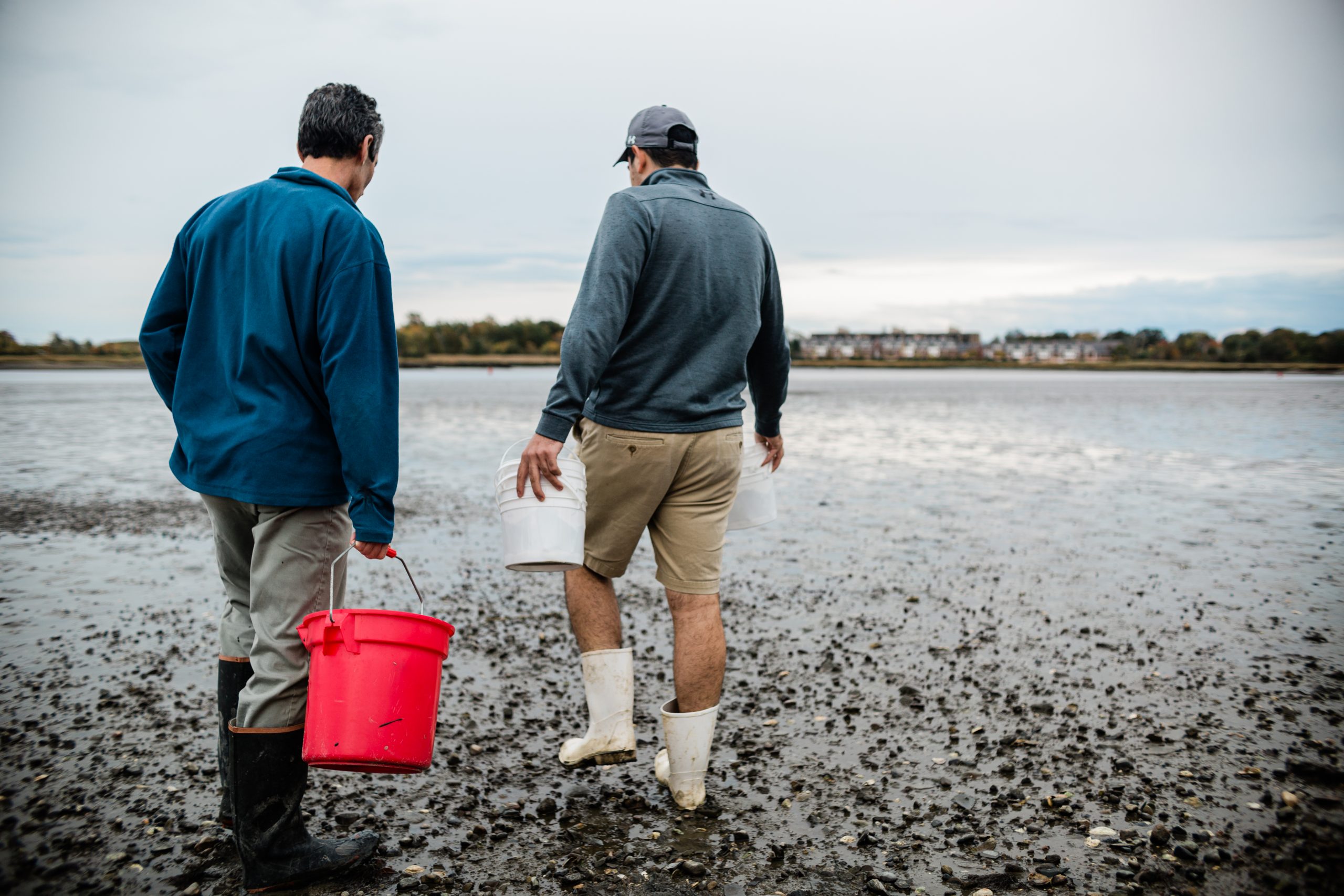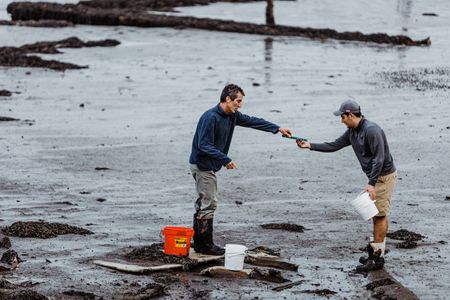Tracking the Spread of Microplastics Polluting the Massachusetts Coast
A loss of balance, the thick sound of slurping and burbling. Gabe Calistro was sinking into the mud. What had seemed idyllic moments before—standing in gently lapping water on an empty estuary, the sun rising from the ocean, the moon dipping into the land—had become a little frightening. His feet were no longer planted on a muddy bank; they were plunging deeper and deeper into it.
Calistro (’21, CAS’23, Pardee’23) was on the shoreline for a new research project that aims to track the spread of microplastics along the Massachusetts coast. For much of the fall, he spent misty mornings and dusky evenings pulling samples from estuaries, mudflats, rivers, and salt marshes to measure the density of the tiny bits of plastic—all under 5 millimeters—in areas north and south of Boston.
But on his first trip, his boot got stuck, mud oozing up to his knee. After a few frantic pulls, he managed to free his foot, and his boot. “It was funny afterwards,” Calistro says.
Worse than the sinking sensation was the smell. If the samples of silt and coastal detritus—a mix of organic fibers, broken shells, rocks, sand, and, potentially, microplastics—aren’t refrigerated, their pungent, coastal bouquet starts rising fast. The stink got into his clothes, sample bags, and his mentor’s car, trailing him back to the lab at BU. But Calistro says the mud and odor are minor inconveniences compared to the potentially long-lasting or devastating impact microplastics—fragments from water bottles, clothes, car tires, and more—may be having on local wildlife and food sources. Scientists have found the tiny bits of plastic everywhere—from Arctic snow and turtle hatchlings to table salt and beer, according to Nature magazine—and are scrambling to figure out what they might be doing to the environment and our health. Calistro, who worked and volunteered at the Shedd Aquarium in his native Chicago during high school, hopes to provide answers about their distribution in Massachusetts.

Unlike most undergraduates involved in research, Calistro isn’t assisting on a professor’s project or helping a graduate student with their own solo effort—the project is all his. He’s designed it, is implementing it, and will write up the results for publication. His work is supported by the Social Impact Research Fund, which targets student-driven projects. The pilot program was launched with funding from Gary A. Kraut (’64, COM’66).
The only faculty involvement is a light guiding hand from Sal Genovese, a lecturer of natural sciences and mathematics. He’s been joining Calistro on some of his sample collecting trips, but “trying to be as hands off as possible, letting Gabe drive the question and direction.”
Genovese compares it to working with a graduate student. “A key developmental stage in becoming a research scientist is that sense of autonomy,” he says. “The difference between directed and independent research is immense.”
Buckets, Mesh, Clippers
On an early fall morning, Calistro and Genovese are up before 5 am to catch the 6:13 am low tide at Revere, Mass., a beachside city just north of Boston. Calistro begins collecting silty samples using a 30 cm x 30 cm square frame, or quadrat, placed a couple of centimeters below the surface of the water; he logs each collection location using GPS.
On this morning, he’s also testing a new filtration system that he hopes will help solve an issue that’s been slowing down—and stinking up—the research.
When he launched the project, he was grabbing as many samples as he could, filling those big gallon bags, then sifting the chunks of debris back at the lab to get to the smaller fragments he wanted to examine for microplastics. But Calistro was running out of fridge space and didn’t have an easy way to dispose of the excess sludge coming along for the ride. The ability to filter the samples on-site would be a big help. Using Kraut’s funding, he bought everything he needed to build a custom specimen strainer: buckets, two sets of metal mesh filters, and wire clippers. He cut holes in the bottom of each bucket, covered the gaps with different size meshes, then stacked them together.

Out in the estuary, Calistro takes the sample from his quadrat, places it on the top mesh, then plunges his contraption into the chilly inlet. Water surges into the buckets, passing through the filters—one with wider 4.5-millimeter holes, the other with tighter 0.9-millimeter holes—and rinsing the sample. When he lifts the buckets, brackish water and specks of silt flow out the bottom: any small debris in the sample is caught by the bottom bucket’s fine mesh base, while the bigger stuff is held back by the top one’s wider filter. The smaller, strained sample is what Calistro calls “the panned gold that is the size range of particles my research is looking at”; the chunkier stuff at the top just gets dumped out.
“It worked,” says Calistro of his bucket and mesh invention, “which was probably the biggest breakthrough I had so far—I’m very proud of it. Now, the samples all fit in 24-ounce containers.”
For Calistro, who’s working two jobs—including at a doggie daycare business—to help pay for college, the funding he used to buy the equipment is vital.
“There’s so many things we’ve had to purchase. Research requires supplies: buckets, shears, filters, waders, gloves, containers,” he says. “If I want to do collecting on my own or with someone else, there’s transportation costs. Funding is necessary to do anything—I’m very grateful.”
When Things Go Wrong
At times, he admits, some of the setbacks have left him wondering if he should give up on the research. Was he using the wrong techniques? Were his problems fixable? With Genovese’s help, he began to see that was all a part of being a scientist.

“A lot of things will go wrong—and that’s OK,” says Calistro. “I’ve had a lot of setbacks. With the collecting, I improved it, had a great success, and went out to the next site location. There’s a lot of trial and error.”
Genovese encourages Calistro to learn from the successes and failures. “Some of the most important lessons might be the least scientific,” he says. As they’re squelching through muddy riverbanks in the chill of the early morning, Genovese often thinks “about that time I spent out in the field with some of my mentors and the example they provided to me. Fieldwork philosophies are passed down from mentor to mentor—not quite an oral history, but a sort of research culture.”
His job on this project isn’t to tell Calistro what to do, he says, but point the way.
Calistro spent much of the fall piling up samples and is now figuring out his next problem: how to analyze them. He hopes to connect with BU Earth & Environment experts for their advice.
“A big part of the process is having students learn how to do research, how to search things out on their own, and then adjust along the way,” says Genovese, whose own studies are focused on the impact of climate change on barnacles.
“A big part of the process is having students learn how to do research, how to search things out on their own, and then adjust along the way.”—Sal Genovese
A double major studying biology and international relations, Calistro says that running a research project “is not something many other people my age will get the opportunity to do.” His goal is to find a career—perhaps with the Environmental Protection Agency or the United Nations—that allows him to combine his majors, creating environmental policies based on research. He hopes the mornings knee-deep in riverbanks or transforming buckets into filters give him an advantage over his peers.
“I do want to go to grad school, and I have this experience that very few people can say they do. It’s extremely amazing and all through the opportunity of a donor providing the funding to do this.”
